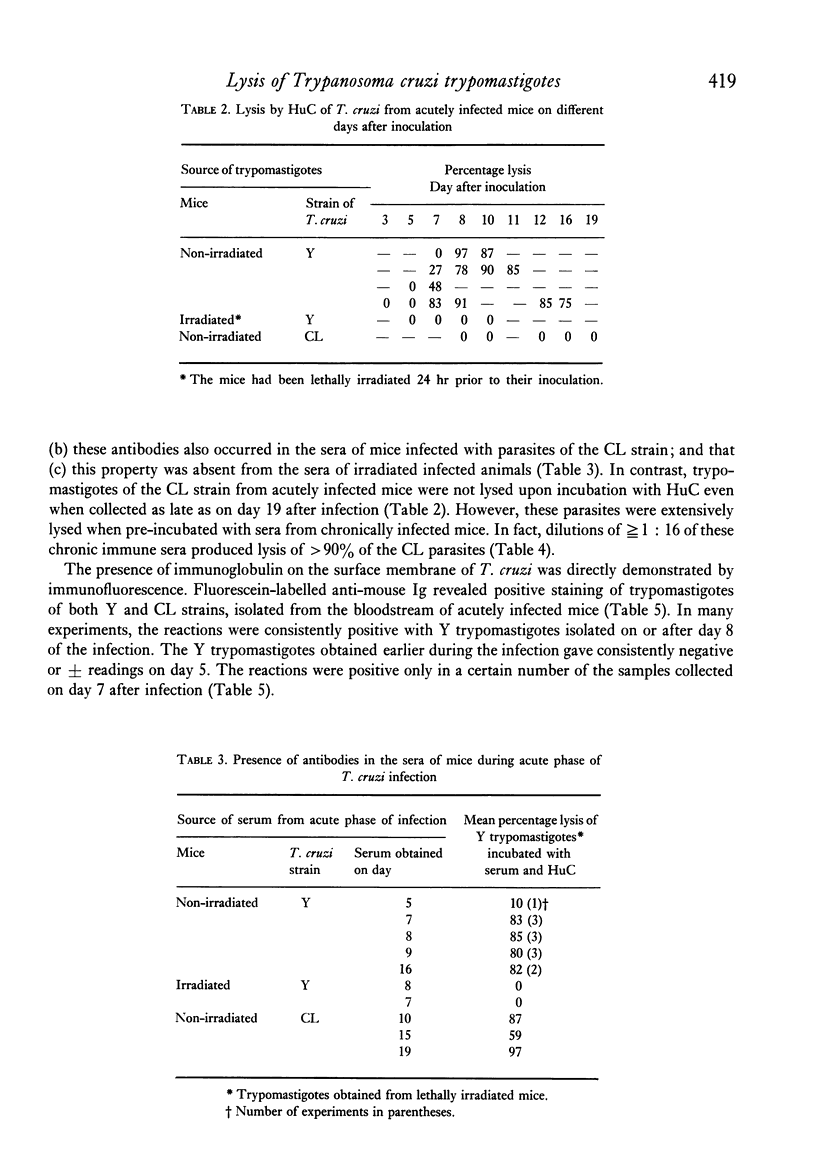Abstract
The Y, CL and other strains of Trypanosoma cruzi display different morphological and immunological characteristics. Such observations are here extended to the interaction of bloodstream forms of different strains of T. cruzi with components of the complement system. We demonstrate that the bloodstream forms of the Y and B strains, but not those of the CL strain, are lysed by normal human serum. Lysis is mediated by combined activities of the alternative and classical complement pathways. These activities are triggered by antibodies on the surface of the parasites as shown by: (a) binding of fluorescein or radiolabelled anti-mouse immunoglobulin to the parasite's membrane and (b) the finding that bloodstream forms from lethally irradiated mice can be sensitized and rendered susceptible to complement-mediated lysis by incubation with sera from acutely infected animals. Bloodstream forms of the CL strain also bear surface immunoglobulin and sensitizing antibodies are present in the sera of mice infected with this strain. However, CL trypomastigotes from acutely infected mice fail to be lysed by human or mouse complement unless the parasites are pre-incubated with sera from chronically infected animals. The basis of the different interactions between CL and Y trypomastigotes with antibodies and the complement system, and their biological significance are discussed.
Full text
PDF







Selected References
These references are in PubMed. This may not be the complete list of references from this article.
- Alcantara A., Brener Z. The in vitro interaction of Trypanosoma cruzi bloodstream forms and mouse peritoneal macrophages. Acta Trop. 1978 Sep;35(3):209–219. [PubMed] [Google Scholar]
- BRENER Z. Therapeutic activity and criterion of cure on mice experimentally infected with Trypanosoma cruzi. Rev Inst Med Trop Sao Paulo. 1962 Nov-Dec;4:389–396. [PubMed] [Google Scholar]
- Brener Z. Biology of Trypanosoma cruzi. Annu Rev Microbiol. 1973;27:347–382. doi: 10.1146/annurev.mi.27.100173.002023. [DOI] [PubMed] [Google Scholar]
- Brener Z., Chiari E. The effects of some immunosuppressive agents in experimental chronic Chagas's disease. Trans R Soc Trop Med Hyg. 1971;65(5):629–636. doi: 10.1016/0035-9203(71)90047-2. [DOI] [PubMed] [Google Scholar]
- Brener Z. The behavior of slender and stout forms of Trypanosoma cruzi in the blood-stream of normal and immune mice. Ann Trop Med Parasitol. 1969 Jun;63(2):215–220. doi: 10.1080/00034983.1969.11686622. [DOI] [PubMed] [Google Scholar]
- Budzko D. B., Pizzimenti M. C., Kierszenbaum F. Effects of complement depletion in experimental chagas disease: immune lysis of virulent blood forms of Trypanosoma cruzi. Infect Immun. 1975 Jan;11(1):86–91. doi: 10.1128/iai.11.1.86-91.1975. [DOI] [PMC free article] [PubMed] [Google Scholar]
- Dwyer D. M. Antibody-induced modulation of Leishmania donovani surface membrane antigens. J Immunol. 1976 Dec;117(6):2081–2091. [PubMed] [Google Scholar]
- Genovesi E. V., Marx P. A., Wheelock E. F. Antigenic modulation of Friend virus erythroleukemic cells in vitro by serum from mice with dormant erythroleukemia. J Exp Med. 1977 Aug 1;146(2):520–534. doi: 10.1084/jem.146.2.520. [DOI] [PMC free article] [PubMed] [Google Scholar]
- Kierszenbaum F., Ivanyi J., Budzko D. B. Mechanisms of natural resistance to trypanosomal infection. Role of complement in avian resistance to Trypanosoma cruzi infection. Immunology. 1976 Jan;30(1):1–6. [PMC free article] [PubMed] [Google Scholar]
- Kloetzel J., Deane M. P. Presence of immunoglobulins on the surface of bloodstream Trypanosoma cruzi. Capping during differentiation in culture. Rev Inst Med Trop Sao Paulo. 1977 Nov-Dec;19(6):397–402. [PubMed] [Google Scholar]
- Krettli A. U., Brener Z. Protective effects of specific antibodies in Trypanosoma cruzi infections. J Immunol. 1976 Mar;116(3):755–760. [PubMed] [Google Scholar]
- Krettli A. U. Exacerbation of experimental Trypanosoma cruzi infection in mice by concomitant malaria. J Protozool. 1977 Nov;24(4):514–518. doi: 10.1111/j.1550-7408.1977.tb01003.x. [DOI] [PubMed] [Google Scholar]
- Melo R. C., Brener Z. Tissue tropism of different Trypanosoma cruzi strains. J Parasitol. 1978 Jun;64(3):475–482. [PubMed] [Google Scholar]
- PILLEMER L., BLUM L., LEPOW I. H., ROSS O. A., TODD E. W., WARDLAW A. C. The properdin system and immunity. I. Demonstration and isolation of a new serum protein, properdin, and its role in immune phenomena. Science. 1954 Aug 20;120(3112):279–285. doi: 10.1126/science.120.3112.279. [DOI] [PubMed] [Google Scholar]
- RUBIO M. Actividad lítica de sueros normales sobre formas de cultivo y sanguíneas de Trypanosoma cruzi. Bol Chil Parasitol. 1956 Oct-Dec;11(4):62–69. [PubMed] [Google Scholar]


